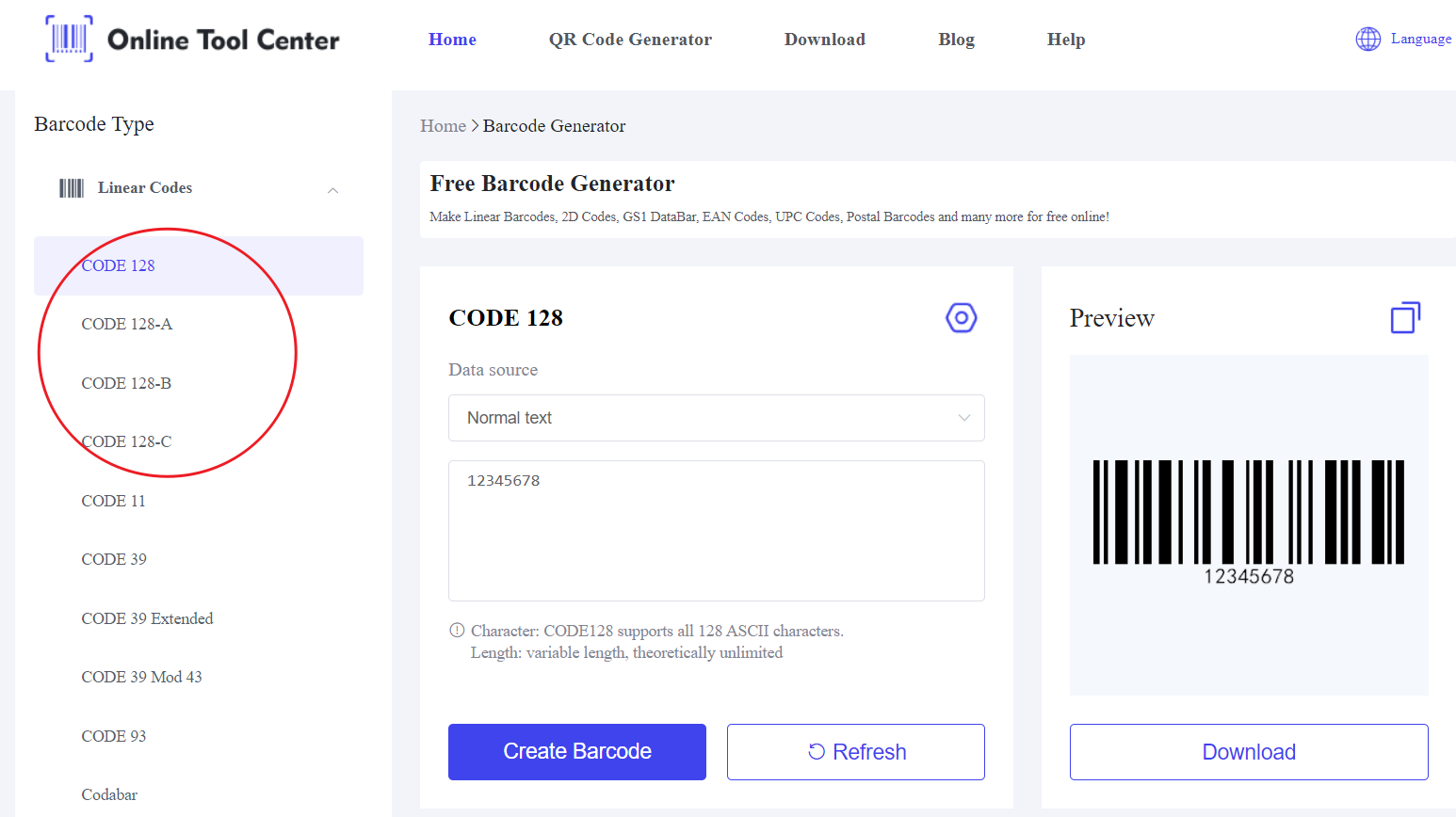Barcodes are critical in modern business operations, among the most versatile and widely used barcode formats is Code 128. It is valued for its ability to encode complex data, including both numbers and letters.
If you are looking for an efficient way to generate these barcodes, our Code 128 creator offers a solution. This article will explore how to generate Code 128 barcodes and learn their applications across different industries.
Code 128 is a linear (1D) barcode format used for encoding alphanumeric data. It is known for its compact size and ability to store a large amount of information within a small space.
What sets Code 128 apart from other barcodes is its ability to use three different character sets (A, B, and C), allowing it to encode a mix of letters, numbers, and special characters efficiently.
Code Set | Characters Supported | Description |
Code 128-A | Uppercase letters (A-Z), Numbers (0-9), Control Characters | Best for encoding uppercase letters and control characters (e.g., start/stop codes). |
Code 128-B | Uppercase and lowercase letters (A-Z, a-z), Numbers (0-9), Special Symbols | Ideal for text with both upper and lowercase letters and special characters. |
Code 128-C | Numeric Pairs (00-99) | Optimized for numbers, encoding two digits per character. Efficient for long numeric strings |
Thanks to this versatility, Code 128 is widely adopted in industries that require detailed product or shipment information in a compact barcode format.
How to Use a Code 128 Barcode Creator?
Using an online Code 128 barcode creator is a quick and reliable way to generate scannable barcodes without requiring complex software. Here's how to use our tool:
1. Enter the Data: Input the desired alphanumeric information, whether it's a product number, shipping label, or other relevant data.

2. Select Code 128 Format: Ensure that you have selected Code 128 as the barcode type.
3. Generate the Barcode: Once the data is input, the Code 128 barcode creator will generate a high-quality barcode.
4. Download Your Barcode: You can download the barcode image in different formats (such as PNG or SVG), making it easy to print or embed into documents.
Applications of Code 128 Barcodes
The Code 128 barcode format is favored across multiple industries due to its flexibility and high-density data encoding. Here are some of the most common applications:
1. Inventory Management
One of the most prevalent uses of Code 128 barcodes is in inventory management systems. Businesses need to track thousands, sometimes millions, of products efficiently.
Using a Code 128 barcode creator, businesses can generate unique barcodes for each product, allowing them to store essential details like product names, SKUs, and stock quantities.
The compact design of Code 128 makes it ideal for situations where space is limited, such as labeling small products.
Additionally, Code 128 is compatible with most barcode scanning systems, making it easy to integrate into existing warehouse management software (WMS) or enterprise resource planning (ERP) systems.
2. Shipping and Logistics
In the shipping and logistics sector, Code 128 is a go-to standard for labeling packages. Shipping companies use these barcodes to encode tracking numbers, destination addresses, and package details.
The ability to handle long sequences of numbers and characters makes Code 128 a practical choice for international shipments, where additional information, such as customs data, may need to be included.
Many shipping labels use Code 128 to track packages across different shipping stages. As the package moves through various checkpoints, barcode scanners read the data, ensuring accurate and timely updates in the system.
3. Retail and Point-of-Sale Systems
In retail environments, Code 128 barcodes are commonly used on product labels for scanning at checkout points. Unlike other barcode types, such as UPC or EAN, Code 128 offers greater flexibility because it can encode both numeric and textual information.
Retailers often rely on Code 128 barcode creators to generate custom labels that meet specific regulatory or marketing needs. By incorporating additional details into a compact barcode, businesses can streamline their pricing, inventory management, and sales processes.
4. Manufacturing and Product Labeling
Manufacturers use Code 128 barcodes to label parts, components, and finished products for tracking throughout the production process. In this context, barcodes can encode batch numbers, serial numbers, and other detailed product data.
Manufacturing plants use Code 128 barcode creators to generate barcodes that are placed on individual components or packaging.
These barcodes ensure that every item can be traced back to its source, improving quality control and enabling more efficient recall management when necessary.
Best Practices for Creating Code 128 Barcodes
To ensure that your barcodes function properly and remain scannable, follow these best practices when using a Code 128 barcode creator:
1. Use High-Resolution Images: Always generate barcodes in high-resolution formats to ensure clarity, especially when printing.
2. Test Barcodes: Before mass printing or applying the barcodes, test them with a barcode scanner to confirm they are readable.
3. Keep the Barcode Clear: Make sure the barcode is free of any obstructions, such as labels or marks that could interfere with scanning.
4. Use the Appropriate Character Set: Choose the right code set (A, B, or C) based on the type of data you're encoding to optimize the barcode's efficiency and size.
In conclusion, Code 128 is one of the most flexible and reliable barcode formats available, widely used across industries such as retail, logistics, and manufacturing. With our easy-to-use Code 128 creator, you can generate barcodes quickly and efficiently to meet your specific needs.
Whether you're managing inventory, handling shipments, or labeling products, our barcode generator provides a seamless way to create high-quality, scannable barcodes.
Ready to create your Code 128 barcode? Try our free barcode generator today!




